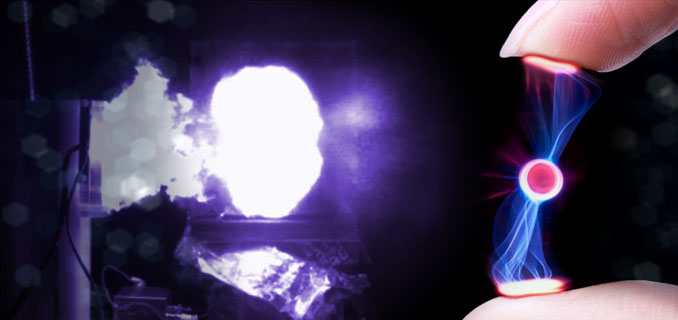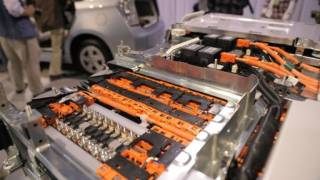New Plasma Device Considered the ‘Holy Grail’ of Energy Generation and Storage
Source: pureenergyblog.com

Scientists at the University of Missouri have devised a new way to create and control plasma that could transform American energy generation and storage.
Randy Curry, professor of electrical and computer engineering at the University of Missouri’s College of Engineering, and his team developed a device that launches a ring of plasma at distances of up to two feet. Although the plasma reaches a temperature hotter than the surface of the sun, it doesn’t emit radiation and is completely safe in proximity to humans.
While most of us are familiar with three states of matter – liquid, gas and solid – there is also a fourth state known as plasma, which includes things such as fire and lightning. Life on Earth depends on the energy emitted by plasma produced during fusion reactions within the sun.
The secret to Curry’s success was developing a way to make plasma form its own self-magnetic field, which holds it together as it travels through the air.
“Launching plasma in open air is the ‘Holy Grail’ in the field of physics,” said Curry.
“Creating plasma in a vacuum tube surrounded by powerful electromagnets is no big deal; dozens of labs can do that. Our innovation allows the plasma to hold itself together while it travels through regular air without any need for containment.”
The plasma device could also be enlarged to handle much larger amounts of energy, he said.
[...]
Read the full article at: pureenergyblog.com
One giant leap for mankind: £13bn Iter project makes breakthrough in the quest for nuclear fusion, a solution to climate change and an age of clean, cheap energy
By Steve Connor | The Independent
It may be the most ambitious scientific venture ever: a global collaboration to create an unlimited supply of clean, cheap energy. And this week it took a crucial step forward.
An idyllic hilltop setting in the Cadarache forest of Provence in the south of France has become the site of an ambitious attempt to harness the nuclear power of the sun and stars.
It is the place where 34 nations representing more than half the world’s population have joined forces in the biggest scientific collaboration on the planet – only the International Space Station is bigger.
The international nuclear fusion project – known as Iter, meaning “the way” in Latin – is designed to demonstrate a new kind of nuclear reactor capable of producing unlimited supplies of cheap, clean, safe and sustainable electricity from atomic fusion.
If Iter demonstrates that it is possible to build commercially-viable fusion reactors then it could become the experiment that saved the world in a century threatened by climate change and an expected three-fold increase in global energy demand.
This week the project gained final approval for the design of the most technically challenging component – the fusion reactor’s “blanket” that will handle the super-heated nuclear fuel.
The building site in Cadarache has also passed the crucial stage where some 493 seismic bearings – giant concrete and rubber plinths – have been set into the reactor’s deep foundations to protect against possible earthquakes.
Peering over the edge of the huge seismic isolation pit, it is still possible to see some of these bearings before they are covered with a raft of reinforced concrete that will support the massive fusion machine at the heart of the £13bn Iter project.
Over the next few years about a million individual components of the highly complex fusion reactor will arrive at the Cadarache site from around the world. They will be assembled like a giant Lego model in a nearby building which has a volume equal to 81 Olympic-sized swimming pools.
Nothing is left to chance in a project that has defied potential Babel-like misunderstandings between the collaborating nations. The design, development and construction of a machine that will attempt to emulate the nuclear fusion reactions of the Sun is proving to be a triumph of diplomacy, as well as science and engineering.
“It is the largest scientific collaboration in the world. In fact, the project is so complex we even had to invent our own currency – known as the Iter Unit of Account – to decide how each country pays its share,” says Carlos Alejaldre, Iter’s deputy director responsible for safety.
“We’ve passed from the design stage to being a construction project. We will have to show it is safe. If we cannot convince the public that this is safe, I don’t think nuclear fusion will be developed anywhere in the world,” Dr Alejaldre said.
“A Fukushima-like accident is impossible at Iter because the fusion reaction is fundamentally safe. Any disturbance from ideal conditions and the reaction will stop. A runaway nuclear reaction and a core meltdown are simply not possible,” he said.
[...]
Read the full article at: telegraph.co.uk
Tune into Red Ice Radio:
Sterling Allan - Hour 1 - Free Energy Technologies Update
Sterling Allan - Hour 1 - Defeating Conspirators: Free Energy Technologies
Sterling Allan - Open Source Free Energy Devices
Mehran Keshe - Iran’s Flying Saucer & Plasma Reactor Technology
Paul Hellyer - The Shadow Government, UFOs & Clean Energy
Ralph Ring - Ether Technology, Magnetism, Nikola Tesla & Otis T. Carr
Nassim Haramein - Unified Field Theory, Gravity, Consciousness & Free Energy
Freddy Silva - Places of Power, Crop Temples, Sound & Light
Maurice Cotterell - FutureScience, The Cycles of the Sun & 2012
Helen Caldicott - Fukushima & Nuclear Energy
http://www.redicecreations.com/radio/2013/03/RIR-130331.php






















